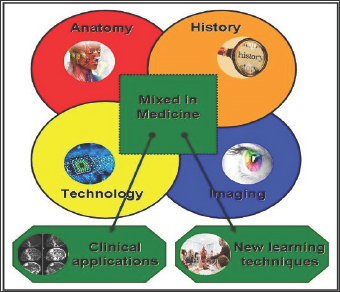Impact Factor : 0.548
- NLM ID: 101723284
- OCoLC: 999826537
- LCCN: 2017202541
Gregory Tsoucalas*1 , Konstantinos Laios2, Efstathia Lagiou3 and Theodoros Papaioannou4
Received: August 22, 2018; Published: September 04, 2018;
*Corresponding author: Gregory Tsoucalas, History of Medicine, Anatomy Department, Medical School, Democritus University of Thrace, Alexandroupolis, Greece
DOI: 10.26717/BJSTR.2018.08.001684
Technology from the Greek term technologies which derives from the words "techno" meaning "art" and "logos" meaning "oration, spiel"  is nowadays defined as "the result of theoretical knowledge in order to create objects-machines that could affect the ability of a species to control its environment and adapt to it [1]. Imaging is defined as "the visual representation of an image which is perceived by human senses or of a form-figure which could not be understood due to its spatial position" [2]. Anatomy is defined as "the medical branch that deals with the study, recording, and description of the structure of living organisms and their individual systems" [3]. The term "history" derives from the Greek word historian (Greek: "lOTOpta"), meaning "inquiry, knowledge acquired by investigation"). History is usually defined as the study of past events, particularly in human affairs [4]. As technology succeeded to manufacture machines able to visualize in depth depictions of the human body, in the narrow area where those for different entities are meet, medical imaging, history and anatomy are being connected through technology to create both clinical and learning curves in medicine (Figure 1).
is nowadays defined as "the result of theoretical knowledge in order to create objects-machines that could affect the ability of a species to control its environment and adapt to it [1]. Imaging is defined as "the visual representation of an image which is perceived by human senses or of a form-figure which could not be understood due to its spatial position" [2]. Anatomy is defined as "the medical branch that deals with the study, recording, and description of the structure of living organisms and their individual systems" [3]. The term "history" derives from the Greek word historian (Greek: "lOTOpta"), meaning "inquiry, knowledge acquired by investigation"). History is usually defined as the study of past events, particularly in human affairs [4]. As technology succeeded to manufacture machines able to visualize in depth depictions of the human body, in the narrow area where those for different entities are meet, medical imaging, history and anatomy are being connected through technology to create both clinical and learning curves in medicine (Figure 1).
Figure 1: The relationship between anatomy, history, technology and imaging in medical science and its results, clinical applications and learning techniques.

Worldwide, human gross anatomy courses form the basis for the medical curricula, aiming to introduce the very core of anatomical concepts within the clinical context both for future and specialized physicians. A solid understanding of the human's body construction is essential for all medical specialties [5]. Although expert medical professionals consider anatomy to be the most relevant basic discipline during their daily clinical activity, students usually perceive anatomy as the more challenging subject, resulting to anxiety and learning difficulties [6-7]. New learning modalities introduced during the last decade towards the formation of a blended learning anatomy courses to help perception and understanding among students. "Blended" is the most used term considering the combination of the more traditional face-to-face or face-to-cadaver experience and technologically mediated learning [8].
Due to rapidly evolving imaging modalities such as computed tomography, magnetic resonance imaging and positron emission tomography and their combinations, radiological images of the human body are utilized almost as a routine practise during both the preclinical education and daily medical work. Understanding radiological images requires good knowledge of gross anatomy, while on the same time radiology enhances this knowledge. Studies support that blended learning is statistically significantly better than traditional learning in most domains of the educational environment and in all types of examination improving students' performance [9]. History of Anatomy and Surgery is among the teaching objects in the Hellenic Universities, an important part of the student’s education, considered to be an essential course for the in depth comprehension of human anatomy. Medical Humanities present during the last decades a fundamental disciplinary among the best universities worldwide [10]. In a four-way relationship, technology and medical imaging alongside with history of anatomy endeavour to accompany gross anatomy towards a fruitful teaching modality in the near future [9]. After all, history is a projection of the past in the present, anatomy is a depiction while technology provides excellent images ... eventually anatomy is, in the very essence of the term, a technology, thus an oration of the art of the human body.


